True Blue Revisited
For five weeks in a row, I am revisiting a series of five articles I wrote thirteen years ago on color philosophy. I am updating them with some of the thoughts I've had since writing the original articles over a decade ago as well as updating them with some more recent examples. Last week, I talked about White ("The Great White Way Revisited") and today I'm going to be talking about blue.
For each color, I'm going to answer the same six questions I answered last time, but with a few more rounded out thoughts. Here are the six questions:
- What does the color desire? What is its end goal?
- What means does the color use to achieve these ends?
- What does the color care about? What does the color represent?
- What does the color despise? What negatively drives the color?
- Why does the color like its allies and hate its enemies?
- What is the color's greatest strength and biggest weakness?
Let's not waste any time and start answering them.

Day's Undoing | Art by Jonas De Ro
What does the color desire? What is its end goal?
Blue wants perfection.
Blue believes that each and every one of us is born a blank slate with the potential to become anything. The entire point of life is figuring out what you could achieve with the right education, experience, and tools. Note that this is not a task with an end goal, but one that continues throughout your life. There will always be things you can do to improve, change, or adapt. The journey of life is one of constant discovery as you keep seeking to better yourself.
In order for individuals to do this, there has to be a society that accepts and encourages this behavior. Opportunities for education are vital. Places to experience things through trial and error are mandatory. Access to the top-of-the-line tools needs to be a right of every citizen.
In addition, this way of living requires the right attitude. You have to be open to possibilities, but also not too hasty in action. Blue recognizes that there are many forces, even some that come from within, that lead an individual astray. Time is a valuable resource because only with time can one get the things they need to improve. This means that individuals need to be careful and deliberate in all their decision making. It is better to think one's options out carefully and select correctly, than to rush to a decision.
Blue is methodical and exact. Because when one sets out to become the best individual they can be, one doesn't have the luxury of making mistakes. Well, not unless they occur within a controlled environment.
Much as blue wishes to perfect itself, it also wants to perfect the world it lives in. Part of this is to ensure that blue has access to the resources it needs, but part of it is the belief that an element of reaching one's potential is living within a world that has reached its own potential. As such, blue is the color most interested in technology and wants the latest and greatest version of whatever it is using.
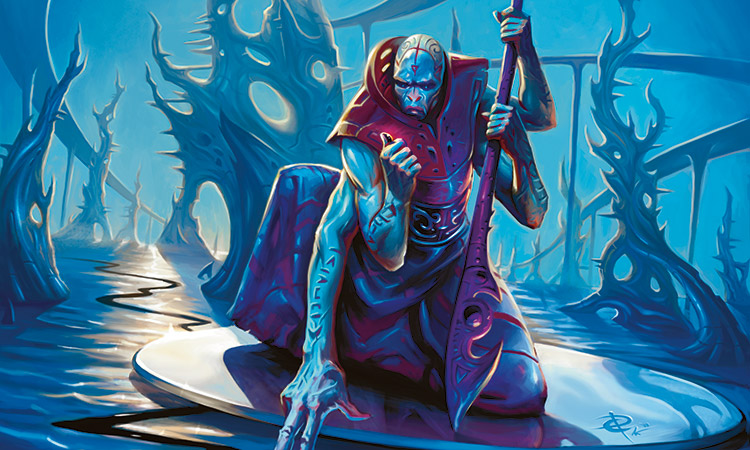
Steady Progress | Art by Efrem Palacios
What means does the color use to achieve these ends?
If reaching one's potential is the goal, the most valuable tool is information. You have to first figure out what your potential is and then you have to track down the means by which you can reach it. The trick is that you don't always know what information is the piece you'll need, so blue has decided to just collect as much information as possible. Knowledge is the ultimate tool and is most effective in the hands of the person that has the most.
The net result of this way of thinking is that blue values the acquisition of any and all knowledge. Individuals with a blue bent are constantly interested in learning everything they do not know and have an insatiable quest to learn more. To blue, the act of learning is its own reward and is something that must be constantly encouraged.
Information can be used in numerous ways other than as a means of improvement. First, it can be a tool of control. By releasing and withholding pieces of information, you can force others to act or not act. Second, it serves as a key. Access is often open to those that know the proper words or actions. Third, it can be a form of protection. Knowing what threats could appear can keep you safe. Fourth, it can be a weapon. The right secret in the right place at the right time can be just as destructive as the mightiest bomb.
In order to facilitate the flow of information, blue wants a structure that enables information to be gathered. Blue likes universities, libraries, and laboratories. Blue wants to surround itself with others also invested in learning. It also likes a highly structured system where its knowledge of that system will give it an edge.
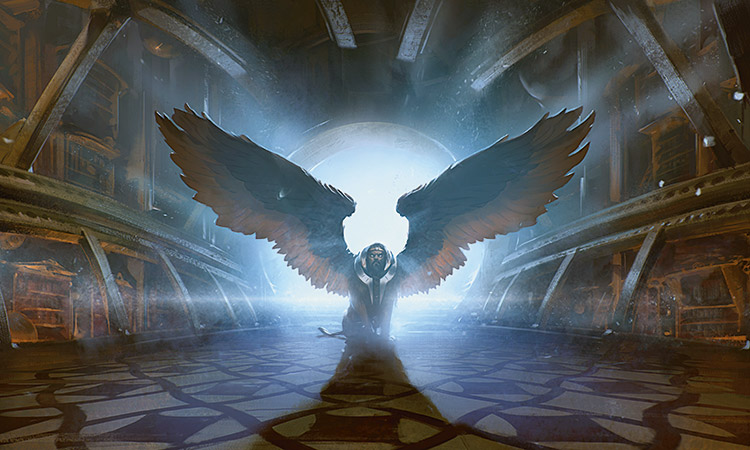
Sphinx's Tutelage | Art by Slawomir Maniak
What does the color care about? What does the color represent?
Here are a number of things that blue cares about along with why:
Academics—If education is the key, then having places to learn is a necessity. Blue is a big supporter of any and all educational systems.
Books & Other Repositories of Information—Blue values any tool that it can use to gather and store information. It treats these items as something special and values them highly.
Mind/Thought—Blue values intellect, and as such is the color that is most often representative of the brain or any means of thinking. Blue is the color most often associated with the mind and any form of logical thought.
Memory—Blue is the color most interested in the idea of how one's memory ties into what an individual knows and does not know. A valuable way to deprive others of information or to give them misinformation is to mess with their memory.
Telepathy—If knowledge is key, then the ability to get it directly out of others' minds is a valuable tool, one blue is willing to make use of.
Telekinesis—Another means of accomplishing physical tasks with the mind is making use of mental energy directly to perform physical actions. As such, mind over matter is another blue tool.
Messing with Time—Yet another resource blue messes around with is the very fabric of time itself. Blue's studies have helped it uncover secrets that none of the other colors are privy to, how to use time as both a resource and a weapon.
Control—Blue doesn't always have the skills it needs to accomplish its tasks, so it has learned the value of using its resource to control those who do. It's an example of a mental process helping solve a physical problem.
Manipulation—Similar to control, manipulation is a way to use information as a tool to get things done. Blue feels that it has a better understanding of the bigger picture and thus manipulation is a necessary tool to get those that don't understand it moving in the right direction.
Trickery—Yet another way to use information as a means of accomplishing a task.
Subtlety—Blue's obsession with details often allows it to function in ways others might not notice. Blue does not want to risk even the tiniest detail derailing its plans.
Complexity—Another means of controlling things is to overwhelm others with too much information. Blue is the color that enjoys complex systems and uses them, at times, as a means to disrupt others.
Artifice—Blue's belief in the value of manipulation and trickery make it willing to create things that are not real in an attempt to confuse others.
Illusion—This type of magic, which thrives on the ignorance of others, plays straight into blue's strength. It is interesting to blue that this type of magic's weakness is knowledge, meaning it can never be used effectively against blue.
Construction/Technology—Blue believes strongly in the importance of tools, so it is on the cutting edge of the resources needed to create them.
Artifacts—As the color that loves technology, blue is the color that has the closest tie to artifacts. It both uses them the most and has the easiest time manipulating them.
Man-Made Items—Blue is the color willing to manufacture whatever is needed. Blue cares in the function of an item, not its origin.
Passivity—Blue's reliance in thinking out solutions makes it the color which most often makes use of inaction.
Cold—Blue's resistance to emotion makes it metaphorically the coldest, and this thematic connection carries over to its magic. Cold has proven a powerful tool, as a means of preventing things from happening.
Elements of Water/Air—Air and water represent mental processes metaphorically, and have become physical attributes the color leans toward. This also plays into blue's conflict with red, which support the elements of fire and earth.
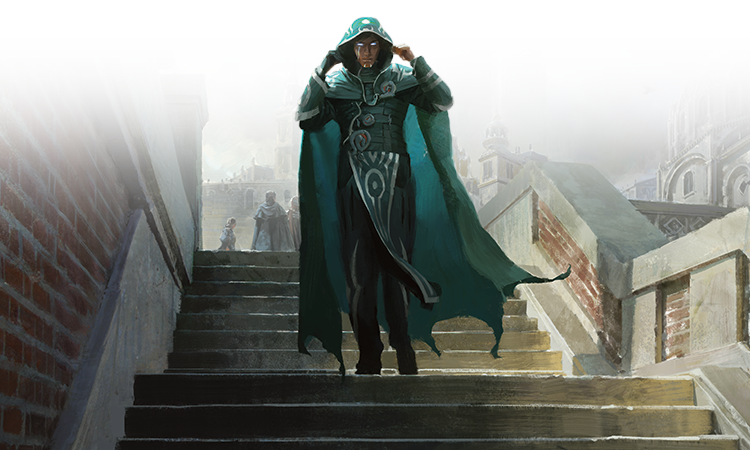
Jace, Telepath Unbound | Art by Jaime Jones
What does the color despise? What negatively drives the color?
Blue is careful and adept at plotting, and thus is resistant to any forces that might force an individual to make a hasty decision. As such, blue dislikes both impulse and instinct. Impulses stem from emotional responses and those are the opposite of intellect. Emotions spur short-sighted actions that satisfy quick-term feelings, but usually at the cost of long-term complications. Blue knows that in order to be successful, you have to keep the big picture in mind and value each decision against the consequences it produces.
Blue dislikes instinct because it represents the shortcomings of biology. Evolution is a painfully slow process, meaning physical reactions are often the result of reacting to problems that have long ago died off. Being a slave to the past is illogical and damaging to blue's larger goals.
Blue also cannot stand any system or process that contradicts the need for progress or change. A big impediment to an individual finding their potential is the denial that such potential either exists or that it has value. Blue thus strongly dislikes traditions and ceremony.

Maritime Guard | Art by Allen Williams
Why does the color like its allies and hate its enemies?
Blue looks at white and sees a fellow color that understands the need to plan and look ahead. Blue admires white's dedication to structure and appreciates its desire to find and fix flaws. Blue is a little frustrated with white's inflexibility and its inability to understand the value of the individual. White also upholds many traditions and ceremonies, which blue feels is unnecessary.
Blue looks at black and appreciates its pragmatism and willingness to do what it needs to do to improve and change. Blue also likes that black values education and tools. Blue's frustration with black lies in the influence it allows its emotions to have in decision-making and the complete disregard of the importance of the group.
Blue looks at red and sees a color that has given in to its emotions, resulting in short-term thinking that jeopardizes long-term goals. Red is reckless and unreliable, as well as destructive and impulsive. Its actions fly in the face of how blue believes individuals need to function.
Blue looks at green and sees a color that believes in nature over nurture. Green denies the very idea that individuals can shape their own future, instead believing in crazy concepts like destiny and predetermination. Green fights the things that blue centers its philosophy around.
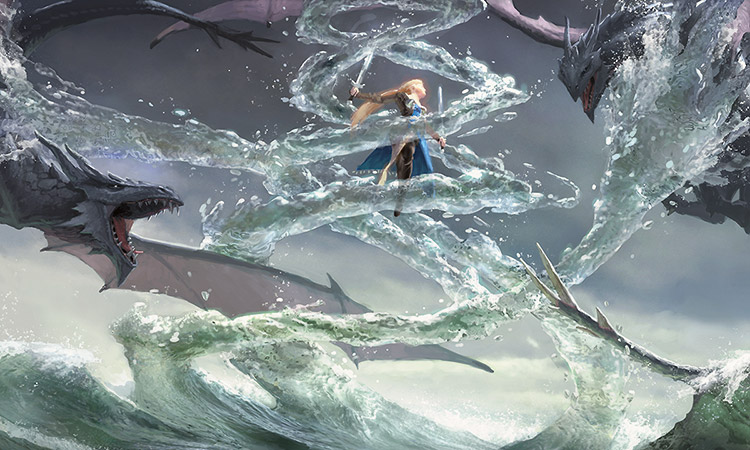
Hydrolash | Art by Clint Cearley
What is the color's greatest strength and biggest weakness?
Blue's greatest strength is its use of knowledge as a tool. Blue values information and thus prioritizes not just its acquisition but also its use. Blue takes the time to examine the big picture and figure out what the consequences are of each action. Blue never acts carelessly or without great thought.
The negative impact of this style of action is that blue can often be very passive. One of the dangers of thinking everything through is the inability to be quick in decision making or be spontaneous in action. Blue will, at times, miss out because other colors have taken the initiative.
Also, blue ends up being very reactive, often waiting for others to take action before doing anything itself. This can cause blue to sometimes have problems when its opponents aren't being proactive.
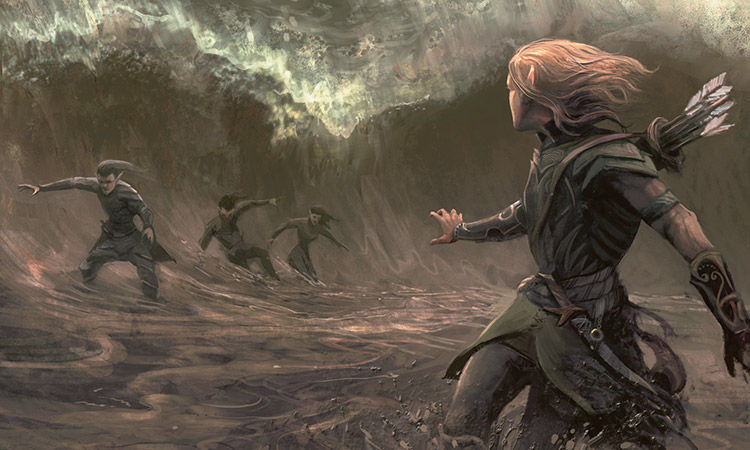
Displacement Wave | Seb McKinnon
Examples of Blue Characters in Recent Pop Culture
Sheldon (Big Bang Theory)
Sheldon is a scientist and a man of great thought. This makes him capable of giant mental insights, yet unable to respond to many of the simple demands of life. He is smart and knowledgeable, yet cannot understand the emotions of others.
Felicity Smoak (Arrow)
Felicity is part of Team Arrow yet she has no physical prowess. Her skills are technological in nature, and often allow her to use her big intellect to save the day.
Edward Nigma (Gotham)
Edward is a forensic police scientist and he thrives on learning about things he does not know. This quest to uncover secrets and his obsession with demonstrating his intellect to others are two of the things that are leading him down the path to becoming the villain known as the Riddler.
Hermoine Granger (Harry Potter)
Hermione is a student at heart and desperately wants to soak up as much information as she can. Her biggest contribution to Harry is the knowledge she holds and her ability to solve the mysteries that he and the team face.
Cosima (Orphan Black)
Cosima is a scientist and her skills lie in uncovering the truth through observation and evaluation. Others in the Clone Club contribute through their ability to physically engage the enemy. Cosima's contributions come through the information she can provide them.
Sherlock Holmes (Elementary)
Sherlock is compelled to challenge himself mentally. He has become a police consultant, not to do good in the world, but rather because he knows he needs the mental stimulation to avoid other destructive behaviors. He constantly strives to improve himself and find others he can train to pass on his knowledge.
Hiro (Big Hero 6)
Hiro's dream is to use his brain to solve the world's problems. He is an inventor and it is the things he creates that give him and his team the ability to save the day.
And finally, the Simpson:
Lisa Simpson (The Simpsons)
Lisa is desperate to learn all she can. She believes that it is this education that will allow her to make something of herself and overcome her handicap of being born a Simpson.
Big Blue
And that, in so many words, is what blue believes and cares about. As always, I am eager to hear your take on my take on blue. You can contact me through my email or through any of my social media (Twitter, Tumblr, Google+, and Instagram).
Join me next week, when it will be time to talk black.
Until then, may you find a way to tap into your own potential.
"Drive to Work #244—Avacyn Restored, Part 4"
This is the fourth and final installment of my series on the design of Avacyn Restored.
"Drive to Work #245—Black/Green"
This is the eighth podcast in my ten-part series on the two-color pairs.
- Episode 245 Black/Green (13.9 MB)
- Episode 244 Avacyn Restored, Part 4 (16.1 MB)
- Episode 243 Avacyn Restored, Part 3 (15.4 MB)
- Episode 242 Avacyn Restored, Part 2 (14.8 MB)
- Episode 241 Avacyn Restored, Part 1 (14.6 MB)

